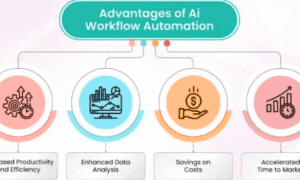Cloud computing can be broken down into different types based on their setup, including public, private, and hybrid clouds. But on top of these basic setups, there are also a few different types of cloud service providers for you to consider.
This article will describe the four most common types, which should help you decide which one will be best for you, help you determine the CapEx and OpEx of utilizing certain cloud services, and allow you to better understand the cloud services your business uses.
Cloud Computing
The first step in understanding cloud services is to understand the basics of cloud computing itself.
Cloud computing is the delivery of computing services over the internet, which may include storage, servers, databases, analytics, and more. As a result, each cloud service is unique, and each may provide you with different services that prove to be imperative in your everyday operations.
For example, one IT service in Century City offers cloud that focuses on building a fast network, and by connecting every employee to it, communication will be swift, and productivity will be increased. Others focus on making an app developer’s life easier, and utilizing this type of cloud service will allow you to create a wide variety of applications quickly. The benefits of cloud computing are many and vast, ranging from being relatively inexpensive to having high security and reliability.
Cloud services can be broken down into a few different types, which we’ll discuss below in greater detail.
Infrastructure as a Service
The moment you decide to utilize a third-party’s computing services instead of managing it all yourself, you lose some control of the services you use—your daily operations will become easier and cheaper in exchange, though.
Infrastructure as a service, or IaaS, is a good example of this, which is a type of cloud service where the cloud provider manages the basic infrastructure for you. This means that the storage, servers, and network are handled by a third party.
You can still access these things; you just can’t update, upgrade, or control their direction yourself. You’ll have access to a dashboard or the API that will allow you to access different parts of the cloud as you see fit. To put it simply, you’ll handle all of the actual software while the cloud provider handles the hardware.
Platform as a Service
Platform as a service or PaaS cloud services may make your web developers happy as this cloud service provides a flexible and scalable platform to develop apps. They can be created, run, and managed easily with PaaS clouds, which is when the provider handles some of the software utilized, such as the operating system or OS.
Development is easier as a result, as developers can pay for what they need when they need it without messing with the OS. Here, the third party will also handle app hosting, development kits, libraries, and other assets that are vital to all types of developers. Since you don’t need to handle owning and storing these assets yourself or creating them when needed, you can save money with PaaS.
However, if you need to have deeper control of the development process, then this may not be the cloud service solution for you.
Serverless Computing
Serverless computing is very similar to PaaS. Both make development easier by allowing many of the services to be handled by a third party, such as the library and OS, as mentioned in the earlier section. However, there are differences between the two that may make one more appealing than the other.
Serverless computing is even-based, which means that when a function is triggered, a server will perform the function and then shut off, while PaaS uses that same server space continuously. Another difference is the ease of scalability; there may be times when you need to scale your operations either up or down, and doing so is a bit easier using serverless computing than with PaaS.
PaaS scaling needs to be configured, while serverless can happen almost immediately; both have their benefits and drawbacks and are often utilized together. If you aren’t sure which is best for you, have a discussion with your developers—they’re deeply aware of what an app they’re making and maintaining needs and may be able to help you understand the benefits and limitations of each available option.
Software as a Service
Software as a Service, also known as SaaS, is a type of service you may not even realize that you’re using, which is a type of cloud service where you simply access a third party’s application. Your modern web-based email provider is a prime example of a SaaS; you log into the platform and can use it, but you can’t update or change the basic functions in any way—the provider handles all of the basics of managing the application and underlying platform.
If owning everything on-site gives you complete control of the entire system, from applications to servers, then SaaS is the exact opposite. Here, the cloud provider handles the hardware, middleware, and software struggles while you simply boot it up and utilize the app’s functions as necessary.
SaaS apps can typically be accessed from a wide range of devices, from a desktop computer to a phone or tablet, and the functionality and appearance of the application shouldn’t vary too widely through smaller screens. Furthermore, the ability to change the screen orientation and other mobile device quirks may result in minor visual and functionality differences.
Being Prepared To Conquer The Cloud
Understanding the cloud in general, the type of cloud service solution you’re currently using, and what you may need to use in the future are all vital in growing your business as technology continues to become more advanced and important.
While we discussed the types of cloud services here, we’re only scratching the surface of what the cloud is and what it’s truly capable of. The future of cloud computer offers business of all kinds untapped promise and potential that we’ve only just begun to scratch the surface of.



































